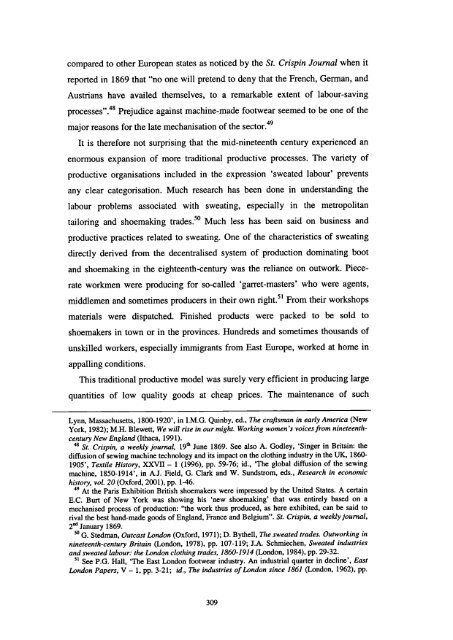The Boot and Shoe Trades in London and Paris in the Long Eighteenth Century
The Boot and Shoe Trades in London and Paris in the Long Eighteenth Century
The Boot and Shoe Trades in London and Paris in the Long Eighteenth Century
Create successful ePaper yourself
Turn your PDF publications into a flip-book with our unique Google optimized e-Paper software.
compared to o<strong>the</strong>r European states as noticed by <strong>the</strong> St. Crisp<strong>in</strong> Journal when it<br />
reported <strong>in</strong> 1869 that "no one will pretend to deny that <strong>the</strong> French, German, <strong>and</strong><br />
Austrians have availed <strong>the</strong>mselves, to a remarkable extent of labour-sav<strong>in</strong>g<br />
processes". 48 Prejudice aga<strong>in</strong>st mach<strong>in</strong>e-made footwear seemed to be one of <strong>the</strong><br />
major reasons for <strong>the</strong> late mechanisation of <strong>the</strong> sector.49<br />
It is <strong>the</strong>refore not surpris<strong>in</strong>g that <strong>the</strong> mid-n<strong>in</strong>eteenth century experienced an<br />
enormous expansion of more traditional productive processes. <strong>The</strong> variety of<br />
productive organisations <strong>in</strong>cluded <strong>in</strong> <strong>the</strong> expression 'sweated labour' prevents<br />
any clear categorisation. Much research has been done <strong>in</strong> underst<strong>and</strong><strong>in</strong>g <strong>the</strong><br />
labour problems associated with sweat<strong>in</strong>g, especially <strong>in</strong> <strong>the</strong> metropolitan<br />
tailor<strong>in</strong>g <strong>and</strong> shoemak<strong>in</strong>g trades. 5° Much less has been said on bus<strong>in</strong>ess <strong>and</strong><br />
productive practices related to sweat<strong>in</strong>g. One of <strong>the</strong> characteristics of sweat<strong>in</strong>g<br />
directly derived from <strong>the</strong> decentralised system of production dom<strong>in</strong>at<strong>in</strong>g boot<br />
<strong>and</strong> shoemak<strong>in</strong>g <strong>in</strong> <strong>the</strong> eighteenth-century was <strong>the</strong> reliance on outwork. Piece-<br />
rate workmen were produc<strong>in</strong>g for so-called 'garret-masters' who were agents,<br />
middlemen <strong>and</strong> sometimes producers <strong>in</strong> <strong>the</strong>ir own right. 5' From <strong>the</strong>ir workshops<br />
materials were dispatched. F<strong>in</strong>ished products were packed to be sold to<br />
shoemakers <strong>in</strong> town or <strong>in</strong> <strong>the</strong> prov<strong>in</strong>ces. Hundreds <strong>and</strong> sometimes thous<strong>and</strong>s of<br />
unskilled workers, especially immigrants from East Europe, worked at home <strong>in</strong><br />
appall<strong>in</strong>g conditions.<br />
This traditional productive model was surely very efficient <strong>in</strong> produc<strong>in</strong>g large<br />
quantities of low quality goods at cheap prices. <strong>The</strong> ma<strong>in</strong>tenance of such<br />
Lynn, Massachusetts, 1800-1920', <strong>in</strong> I.M.G. Qu<strong>in</strong>by, ed., <strong>The</strong> craftsman <strong>in</strong> early America (New<br />
York, 1982); M.H. Blewett, We will rise <strong>in</strong> our might. Work<strong>in</strong>g women's voices from n<strong>in</strong>eteenthcentury<br />
New Engl<strong>and</strong> (Ithaca, 1991).<br />
48 St. Crisp<strong>in</strong>, a weekly journal, 19th June 1869. See also A. Godley, 'S<strong>in</strong>ger <strong>in</strong> Brita<strong>in</strong>: <strong>the</strong><br />
diffusion of sew<strong>in</strong>g mach<strong>in</strong>e technology <strong>and</strong> its impact on <strong>the</strong> cloth<strong>in</strong>g <strong>in</strong>dustry <strong>in</strong> <strong>the</strong> UK, 1860-<br />
1905', Textile History, XXVII - 1 (1996), pp. 59-76; id., '<strong>The</strong> global diffusion of <strong>the</strong> sew<strong>in</strong>g<br />
mach<strong>in</strong>e, 1850-1914', <strong>in</strong> A.J. Field, 0. Clark <strong>and</strong> W. Sundstrom, eds., Research <strong>in</strong> economic<br />
history, vol. 20 (Oxford, 2001), pp. 1-46.<br />
At <strong>the</strong> <strong>Paris</strong> Exhibition British shoemakers were impressed by <strong>the</strong> United States. A certa<strong>in</strong><br />
E.C. Burt of New York was show<strong>in</strong>g his 'new shoemak<strong>in</strong>g' that was entirely based on a<br />
mechanised process of production: "<strong>the</strong> work thus produced, as here exhibited, can be said to<br />
rival <strong>the</strong> best h<strong>and</strong>-made goods of Engl<strong>and</strong>, France <strong>and</strong> Belgium". St. Crisp<strong>in</strong>, a weekly journal,<br />
2' January 1869.<br />
0. Stedman, Outcast <strong>London</strong> (Oxford, 1971); D. By<strong>the</strong>ll, <strong>The</strong> sweated trades. Outwork<strong>in</strong>g <strong>in</strong><br />
n<strong>in</strong>eteenth-century Brita<strong>in</strong> (<strong>London</strong>, 1978), pp. 107-119; J.A. Schmiechen, Sweated <strong>in</strong>dustries<br />
<strong>and</strong> sweated labour: <strong>the</strong> <strong>London</strong> cloth<strong>in</strong>g trades, 1 860-1914 (<strong>London</strong>, 1984), pp. 29-32.<br />
' See P.G. Hall, '<strong>The</strong> East <strong>London</strong> footwear <strong>in</strong>dustry. An <strong>in</strong>dustrial quarter <strong>in</strong> decl<strong>in</strong>e', East<br />
<strong>London</strong> Papers, V - 1, pp. 3-21; id., <strong>The</strong> <strong>in</strong>dustries of <strong>London</strong> s<strong>in</strong>ce 1861 (<strong>London</strong>, 1962), pp.<br />
309


